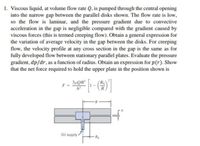
Structural Analysis
6th Edition
ISBN: 9781337630931
Author: KASSIMALI, Aslam.
Publisher: Cengage,
expand_more
expand_more
format_list_bulleted
Concept explainers
Question

Transcribed Image Text:1. Viscous liquid, at volume flow rate Q, is pumped through the central opening
into the narrow gap between the parallel disks shown. The flow rate is low,
so the flow is laminar, and the pressure gradient due to convective
acceleration in the gap is negligible compared with the gradient caused by
viscous forces (this is termed creeping flow). Obtain a general expression for
the variation of average velocity in the gap between the disks. For creeping
flow, the velocity profile at any cross section in the gap is the same as for
fully developed flow between stationary parallel plates. Evaluate the pressure
gradient, dp/dr, as a function of radius. Obtain an expression for p(r). Show
that the net force required to hold the upper plate in the position shown is
3µQR
F
R
Oil supply
Ro
Expert Solution
This question has been solved!
Explore an expertly crafted, step-by-step solution for a thorough understanding of key concepts.
This is a popular solution
Trending nowThis is a popular solution!
Step by stepSolved in 3 steps with 3 images

Knowledge Booster
Learn more about
Need a deep-dive on the concept behind this application? Look no further. Learn more about this topic, civil-engineering and related others by exploring similar questions and additional content below.Similar questions
- 2xy, v = x² – y², is irrotational and incompressible, and determine its stream function and velocity potential p. 2. Demonstrate that the two-dimensional flow fluid flow defined by u =arrow_forwardConsider the two-dimensional flow of an inviscid, incompressible fluid described by the superposition of a parallel flow of velocity V0, a source of strength q, and a sink of strength −q, separated by a distance b in the direction of the parallel flow, the source being upstream of the sink. (a) Find the resultant stream function and velocity potential. (b) Sketch the streamline pattern. (c) Find the location of the upstream stagnation point relative to the source.arrow_forwardIn using Darcy-Weisbach equation for flow in a pipe, the friction factor is misjudged by + 25%. The resulting error in the estimated discharge Q isarrow_forward
- The laminar flow takes place between closely spaced parallel plates as shown in figure below. u > V y Ľ The velocity profile is given by u = v. The gap height h is 5 mm and the space is filled with oil (specific gravity = 0.86, viscosity μ = 2 x 10-4 N-s/m²). The bottom plate is stationary and the top plate moves with a steady velocity of v= 5cm/s. The area of the plate is 0.25 m². The rate of rotation of a fluid particles is given byarrow_forwardConsider a system where a horizontal, laminar, separated flow of air and water at 100 kPa pressure and 20 C temperature are moving between two infinitely-sized parallel plates. The water flow is not forced, but is carried along by the air flow. The 'superficial velocity' of the air is 0.1 m/s (superficial velocity is volume flow rate / flow area, representing the average velocity of the flow). The depth of the water film is 2 mm and the thickness of the air layer is 5 mm. Use the multiphase balance equations and interfacial boundary conditions to derive the velocity profile in the air and water, with y=D0 being the interface between the two.arrow_forward
arrow_back_ios
arrow_forward_ios
Recommended textbooks for you

 Structural Analysis (10th Edition)Civil EngineeringISBN:9780134610672Author:Russell C. HibbelerPublisher:PEARSON
Structural Analysis (10th Edition)Civil EngineeringISBN:9780134610672Author:Russell C. HibbelerPublisher:PEARSON Principles of Foundation Engineering (MindTap Cou...Civil EngineeringISBN:9781337705028Author:Braja M. Das, Nagaratnam SivakuganPublisher:Cengage Learning
Principles of Foundation Engineering (MindTap Cou...Civil EngineeringISBN:9781337705028Author:Braja M. Das, Nagaratnam SivakuganPublisher:Cengage Learning Fundamentals of Structural AnalysisCivil EngineeringISBN:9780073398006Author:Kenneth M. Leet Emeritus, Chia-Ming Uang, Joel LanningPublisher:McGraw-Hill Education
Fundamentals of Structural AnalysisCivil EngineeringISBN:9780073398006Author:Kenneth M. Leet Emeritus, Chia-Ming Uang, Joel LanningPublisher:McGraw-Hill Education
 Traffic and Highway EngineeringCivil EngineeringISBN:9781305156241Author:Garber, Nicholas J.Publisher:Cengage Learning
Traffic and Highway EngineeringCivil EngineeringISBN:9781305156241Author:Garber, Nicholas J.Publisher:Cengage Learning


Structural Analysis (10th Edition)
Civil Engineering
ISBN:9780134610672
Author:Russell C. Hibbeler
Publisher:PEARSON

Principles of Foundation Engineering (MindTap Cou...
Civil Engineering
ISBN:9781337705028
Author:Braja M. Das, Nagaratnam Sivakugan
Publisher:Cengage Learning

Fundamentals of Structural Analysis
Civil Engineering
ISBN:9780073398006
Author:Kenneth M. Leet Emeritus, Chia-Ming Uang, Joel Lanning
Publisher:McGraw-Hill Education


Traffic and Highway Engineering
Civil Engineering
ISBN:9781305156241
Author:Garber, Nicholas J.
Publisher:Cengage Learning